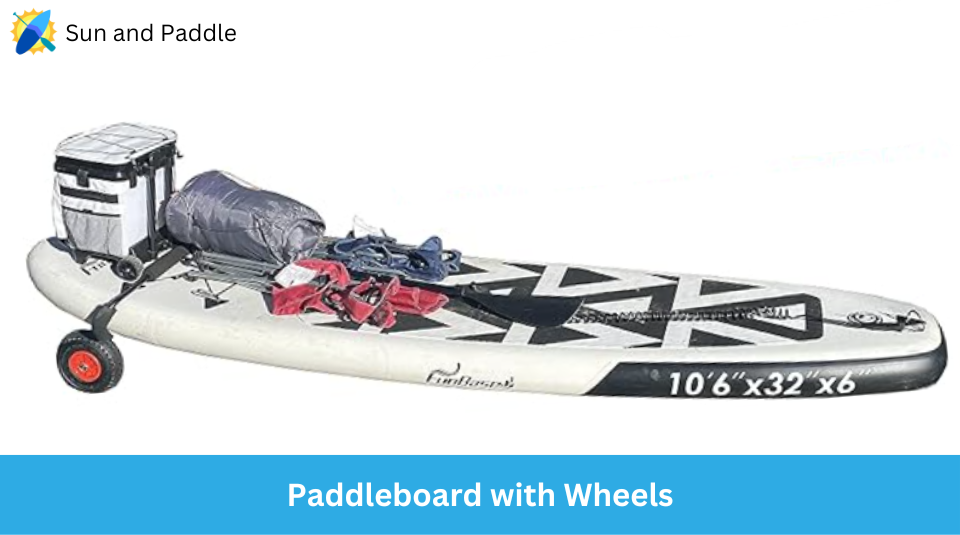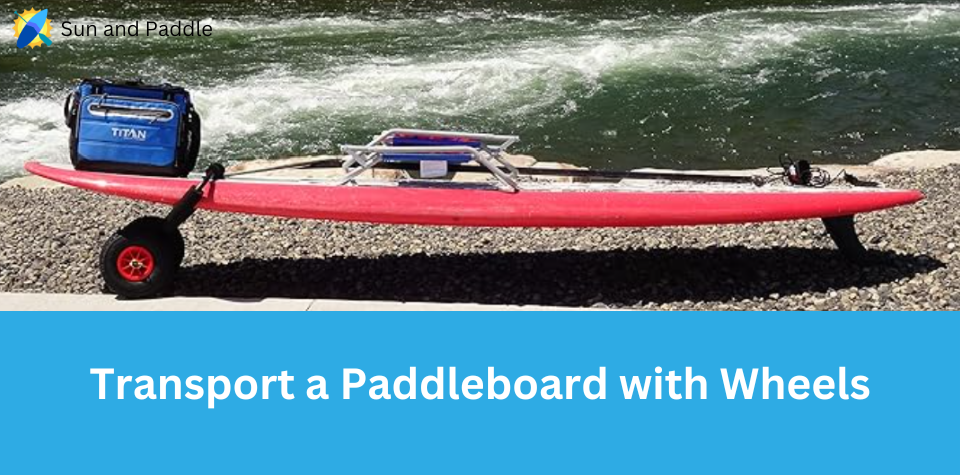SUP enthusiasts know the fun starts long before they put their boards in the water. But getting from your car to the water’s edge can sometimes feel like a hard job, especially if you’re carrying a giant paddleboard or going through rough terrain. This is where the clever use of wheels to move your SUP comes into play, turning what used to be a problem into a smooth and enjoyable part of the whole experience. It’s about making things easier, putting less pressure on your body, and saving your energy for when you’re gliding across the water, enjoying every stroke and nature’s beauty.
Loading SUP onto Wheels
Putting your Stand-Up Paddleboard (SUP) on wheels is the first step toward an easy and fun way to move it. This critical step requires you to carefully place the back of your SUP on the rubber bumpers of the wheeled carrier. These rubbery supports act as a cushion and give your SUP the grip it needs to stay in place while you travel. It’s a moment of getting ready in which you protect your board from possible damage and set up a stable, reliable base for easy and smooth travel. This step sets you up for a fun and easy trip, so you can focus on paddling instead of worrying about how to get your SUP to the water’s edge.

Lay the Back of the SUP onto the Rubber Protections
Preparing your Stand-Up Paddleboard (SUP) for a worry-free day of fun on the water is an essential first step that sets the tone for the day. This process starts with carefully putting your paddleboard on your wheeled transport so that the back of the board rests firmly on the specially made rubber protections. These rubberized supports do two things: they provide a soft, cushioned surface that cradles your SUP, protecting it from the bumps and waves of the trip, and they have an excellent grip that keeps it from moving around. These plastic guards are the first defense against damage to your expensive board. You can confidently go on your water adventure, knowing that your SUP is well-protected and snugly tucked away for the trip ahead.
A crucial part of ensuring your Stand-Up Paddleboard (SUP) is safe and easy to move is to lay the back on the rubber protection. This is the most crucial step because it gives your boat a stable base while you’re moving. The rubber guards not only have a soft surface that protects against dents, scratches, and damage from impacts, but they also have a non-slip base. This keeps your SUP from moving or sliding around while transporting it, reducing the chance of crashes or instability. By following this step, you not only protect your expensive board but also set yourself up for a worry-free and fun trip to the water, where you can focus on the fun of paddleboarding instead of worrying about the safety of your gear.
Move the Straps into Position over the SUP, Then Tighten
After successfully putting your SUP on the wheels, the next important step is to ensure it stays in place for the whole trip. This is why putting the straps in the right places and tying them down well is essential. These straps protect your paddleboard like a harness, ensuring it doesn’t move, shake, or fall off during transport. The key is to find the right mix between securing your SUP tightly and not tightening it too much since that could damage the board or the wheels. When appropriately fastened, these straps give you peace of mind, knowing that your SUP is resting comfortably on wheels and firmly in place. This lets you confidently move across different terrains and focus on the fun of your upcoming paddleboarding trip.
Moving the straps over the SUP and then tightening them is a significant step for making sure that transporting the SUP is safe and doesn’t cause any stress. These straps basically protect your Stand-Up Paddleboard (SUP) while it’s in travel. They keep it from moving or shifting in ways that could cause damage or accidents. When you put your SUP in the right place, you protect the board’s soundness and the safety of nearby people and things. But it’s essential to find the right balance: tightening the straps enough but not too much keeps the board stable without putting too much pressure or strain on your expensive paddleboard. At the end of the day, this step gives you peace of mind that your SUP is tight and secure, so you can go on your water trip confidently, knowing that your board is in good hands.
When Walking with Wheels
When walking with wheels, you’ve reached the point in your Stand-Up Paddleboard (SUP) transportation path where convenience and practicality meet. The most important thing is to hold the SUP by the front and keep it off the ground. By doing this, you make sure that your paddleboard rolls easily on the wheels. This reduces friction and lets you move gracefully and quickly over different surfaces. This method saves your energy and protects your SUP and its wheels from wear and tear, making them last longer. Whether moving across sandy shores, uneven roads, or any other terrain, this method ensures a smooth and quick trip to the water’s edge, making getting your SUP into the water as fun as paddleboarding.
Hold the SUP by the Front, Keeping it Off the Ground
Now that you’ve put your SUP on wheels, it’s time to hit the road and quickly get to the water’s edge. To do this, grab the front of your SUP and keep it off the ground. By slightly lifting the front of the board, you can ensure it doesn’t drag or scrape on the wheels. This method lowers friction and makes moving over a wide range of surfaces much more manageable, from sandy beaches to bumpy paths.
When transporting the SUP on wheels, holding it by the front and keeping it off the ground is essential. This method is a crucial part of keeping your Stand-Up Paddleboard (SUP) in good shape and ensuring that your water trip is smooth and easy. By lifting the front of the board a little and letting the wheels take the weight, you can reduce friction and the chance that the bottom will get scratched or damaged. Also, it makes it easier to move around on sandy beaches, gravel paths, and other uneven areas by making it easier to move around. This method not only makes your SUP and wheels last longer, but it also saves your energy. When you get to the water’s edge, you’ll be ready to paddleboard without pulling the board, which can be hard on your body and cause damage.
Using wheels to move your SUP makes getting from your car to the water more accessible, so you can focus on the fun waiting for you. By following these steps for putting your SUP on wheels and using the right way to walk with wheels, you can get to your favorite paddling spot quickly and without stress. So, prepare, roll out, and prepare for a SUP experience on the water that you will remember.

